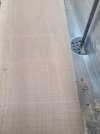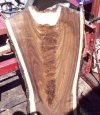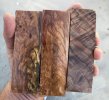Greetings. I acquired a dead black walnut tree. Eventual use will be knife handles and bartering. It was left standing for 1 year after no visible evidence of life. I had a professional tree company fall it for me last weekend. The base is 23" diameter, with a slow taper for 12' of trunk, and then all the branches with a variety of diameters. The tree company had to cut the trunk into 2, 6' pieces in order to lift it onto my trailer. The moisture measurements are all over the place. The heart wood of the trunk base is still at 35%, with 11% just under the bark. The smaller the diameter, the lower the moisture. Some in the 10-15% range.
I have a local wood craft / furniture company willing to cut it for me. Questions:
1) I assume standard quarter sawn procedure would show the best rays and grain?? Better than just straight slabs? I am thinking 2" thickness slabs?
2) Is there any way to look at a tree and have some idea where the heavily figured patterns will be? I am thinking base of trunk and at crotches?? There was no burl. I could not dig out the root ball because of landscaping Rhododendron plants and a vinyl fence that we needed to protect. (Thank you, Lord. Huge project for someone in their metalic years.) I guess I will see it after it is cut up.
3) I sealed the saw cut ends with latex primer paint. After it is cut up and I am strapping it down for curing, does the end grain still need to be sealed?
Thanks for your help. Kirt
I have a local wood craft / furniture company willing to cut it for me. Questions:
1) I assume standard quarter sawn procedure would show the best rays and grain?? Better than just straight slabs? I am thinking 2" thickness slabs?
2) Is there any way to look at a tree and have some idea where the heavily figured patterns will be? I am thinking base of trunk and at crotches?? There was no burl. I could not dig out the root ball because of landscaping Rhododendron plants and a vinyl fence that we needed to protect. (Thank you, Lord. Huge project for someone in their metalic years.) I guess I will see it after it is cut up.
3) I sealed the saw cut ends with latex primer paint. After it is cut up and I am strapping it down for curing, does the end grain still need to be sealed?
Thanks for your help. Kirt



